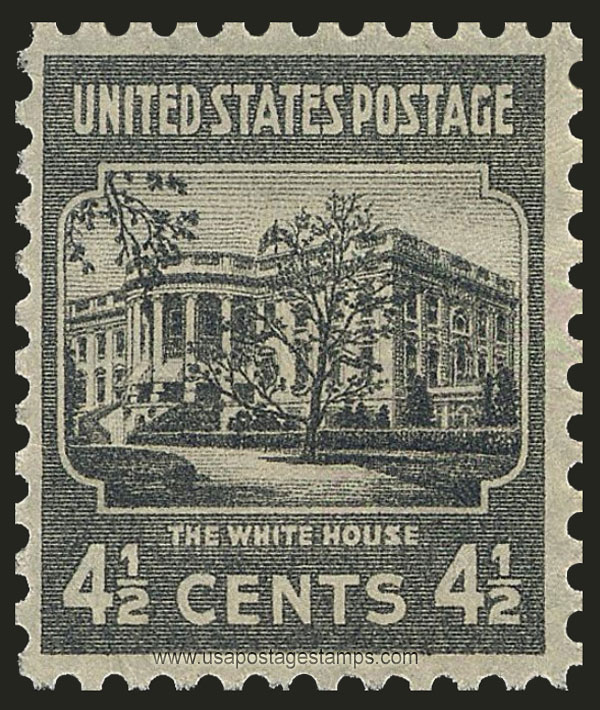US 1938 The White House, Washington, D.C. 4½c. Scott. 809

Series: Presidential Issue
Stamp details: The White House (1792), Washington, D.C.
Issued date: 11-07-1938 (dd/mm/yyyy)
Face value: 4½c.
Emission: Definitive
Watermark: No Watermark
Catalogue No:-
Scott (USA): 809
Stanley Gibbons (UK): 805
Michel (Germany): 416A
Yvert et Tellier (France): 374
Dimensions (height x width):
25.4mm x 22.2mm
Printer: Bureau of Engraving and Printing
Print Method: Rotary press
Stamp Colors: Dark grey
Perforation: Perf 11 x 10½
Gum type: Water activated
Themes: Monument, Building
Total print: 275,455,900 (estimate)
Note: The 4½c. stamp paid three times the third class rate, as well as triple the book rate, in this case up to 3 pounds. It was generally used in multiples or with other stamps, often with another fractional stamp, to make up a postage rate.
Stamp details: The White House (1792), Washington, D.C.
Issued date: 11-07-1938 (dd/mm/yyyy)
Face value: 4½c.
Emission: Definitive
Watermark: No Watermark
Catalogue No:-
Scott (USA): 809
Stanley Gibbons (UK): 805
Michel (Germany): 416A
Yvert et Tellier (France): 374
Dimensions (height x width):
25.4mm x 22.2mm
Printer: Bureau of Engraving and Printing
Print Method: Rotary press
Stamp Colors: Dark grey
Perforation: Perf 11 x 10½
Gum type: Water activated
Themes: Monument, Building
Total print: 275,455,900 (estimate)
Note: The 4½c. stamp paid three times the third class rate, as well as triple the book rate, in this case up to 3 pounds. It was generally used in multiples or with other stamps, often with another fractional stamp, to make up a postage rate.
Description:- The White House is the Official residence and workplace of the President of the United States. It is located at 1600 Pennsylvania Avenue NW in Washington, D.C., and has been the residence of every U.S. president since John Adams in 1800. The term "White House" is often used as a metonym for the president and his advisers.
The residence was designed by Irish-born architect James Hoban in the neoclassical style. Hoban modelled the building on Leinster House in Dublin, a building which today houses the Oireachtas, the Irish legislature. Construction took place between 1792 and 1800, using Aquia Creek sandstone painted white. When Thomas Jefferson moved into the house in 1801, he (with architect Benjamin Henry Latrobe) added low colonnades on each wing that concealed stables and storage. In 1814, during the War of 1812, the mansion was set ablaze by the British Army in the Burning of Washington, destroying the interior and charring much of the exterior. Reconstruction began almost immediately, and President James Monroe moved into the partially reconstructed Executive Residence in October 1817. Exterior construction continued with the addition of the semi-circular South portico in 1824 and the North portico in 1829.
Source: en.wikipedia.org/wiki/White_House
The residence was designed by Irish-born architect James Hoban in the neoclassical style. Hoban modelled the building on Leinster House in Dublin, a building which today houses the Oireachtas, the Irish legislature. Construction took place between 1792 and 1800, using Aquia Creek sandstone painted white. When Thomas Jefferson moved into the house in 1801, he (with architect Benjamin Henry Latrobe) added low colonnades on each wing that concealed stables and storage. In 1814, during the War of 1812, the mansion was set ablaze by the British Army in the Burning of Washington, destroying the interior and charring much of the exterior. Reconstruction began almost immediately, and President James Monroe moved into the partially reconstructed Executive Residence in October 1817. Exterior construction continued with the addition of the semi-circular South portico in 1824 and the North portico in 1829.
Source: en.wikipedia.org/wiki/White_House




